Desert Plants: 10 Beautiful Succulents for Your Indoor Collection
Have you ever felt that pang of guilt after watching yet another houseplant wither away under your care? The dried leaves, the drooping stems—silent witnesses to our busy lives. But what if there was a way to bring nature’s resilience into your home? Desert plants, particularly succulents, have evolved over millennia to thrive in the harshest conditions on Earth. Today, they offer us not just their beauty but a second chance at becoming plant parents without the heartbreak.
Table of Contents
Table of Contents
Understanding Desert Plants and Their Indoor Appeal
Before diving into specific varieties, let’s explore why desert plants make exceptional indoor companions. Unlike their fussy tropical counterparts, these botanical survivors bring a unique set of advantages to your living spaces.
What Makes Desert Plants Perfect for Indoor Spaces
When considering which greenery to welcome into your home, desert plants stand apart for several compelling reasons:
- Natural adaptation to drought conditions allows these plants to forgive occasional neglect
- The ability to thrive in warm, dry indoor environments matches the typical home atmosphere
- Minimal maintenance requirements suit busy lifestyles and novice plant enthusiasts
- Architectural shapes and unique aesthetics create striking visual interest beyond typical foliage
- Air-purifying qualities contribute to healthier indoor environments without demanding constant attention
Desert plants don’t simply survive indoors—they prefer many aspects of indoor living. The controlled temperature, protection from extreme elements, and consistent environment often mirror their natural habitats more closely than you might imagine.
The Rise of Succulent Popularity in Home Decor
The explosion of desert plants in interior design isn’t merely coincidental. Their surge in popularity connects to several contemporary lifestyle movements:
- Social media influence on plant trends has showcased their photogenic qualities
- Minimalist design compatibility aligns with clean, uncluttered aesthetic preferences
- The sustainability movement connection appeals to environmentally conscious consumers
- The mental health benefits of indoor gardening provide satisfaction without overwhelming responsibility
While passing trends come and go, the practical appeal of desert plants suggests their prominence in home spaces represents more than a fleeting fascination. Their sustainable beauty resonates with modern values of mindfulness, authenticity, and connection to nature.

ZOUTOG Succulent Pots 3.15 Inch
4 Pack Succulent Planters,Small Pots for Plants with Drainage and Tray,White Ceramic Flower Planters for Indoor Plants,Home,Office,Desk
Buy now from Amazon
The Top 10 Desert Plants for Your Indoor Collection
Ready to begin your desert plant journey? These ten extraordinary specimens offer the perfect starting point for transforming your space.
1. Echeveria: The Rose of the Desert
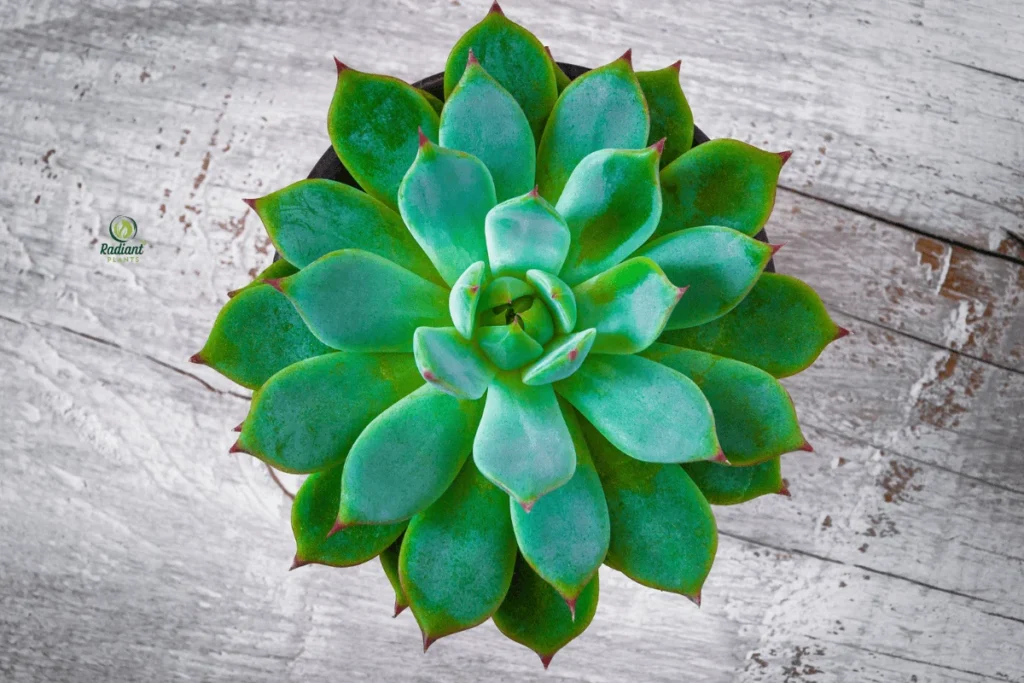
Echeverias captivate with their perfect symmetry and the reminiscence of opening roses. These rosette-forming succulents have become staples in indoor collections worldwide.
Their distinctive characteristics include:
- Distinctive rosette shape with blue-green leaves creating a living sculpture
- Various colorful varieties are available, spanning pastel pinks, moody purples, and silvery blues
- Care requirements: bright indirect light, minimal watering, making them suitable for sunny windowsills
- Propagation tips from leaf cuttings allow for easy collection and expansion
Echeverias respond beautifully to proper light, developing intense colors when positioned correctly. Place them where they’ll receive bright, filtered sunlight for four to six hours daily, and watch their colors intensify naturally.
2. Haworthia: The Perfect Desk Companion
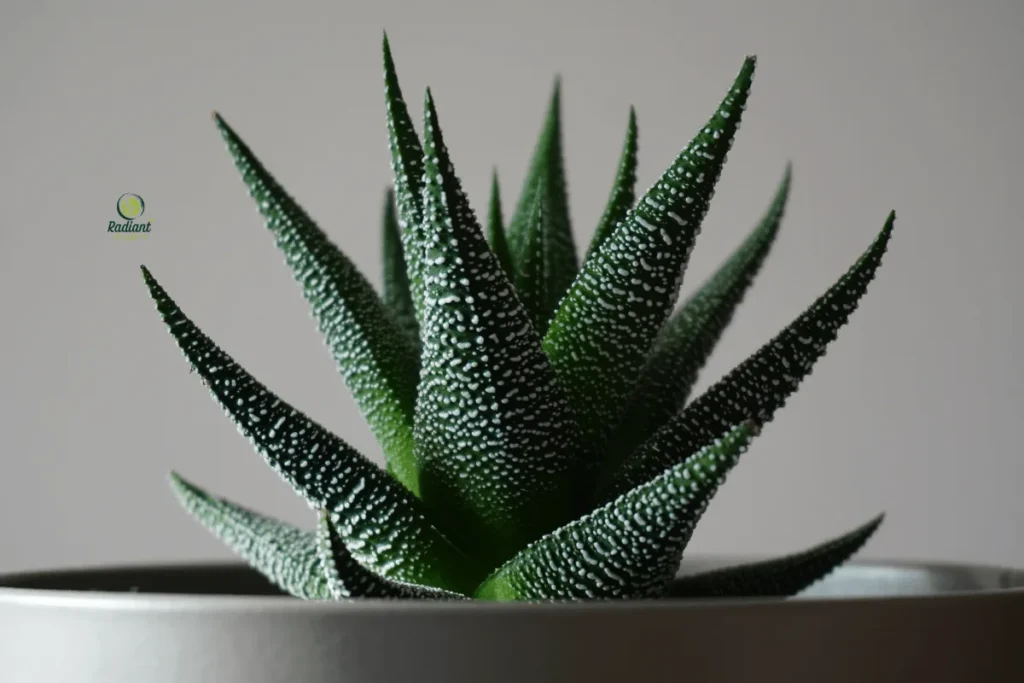
For those craving greenery in smaller spaces, Haworthias provide the perfect solution. These compact gems tolerate lower light conditions than many other succulents, making them ideal for offices and north-facing windows.
Haworthias stand out for their:
- Compact size ideal for small spaces, fitting perfectly on desks and shelves
- Distinctive zebra-striped varieties create visual interest without overwhelmingthe surroundings
- Tolerance for low light conditions, accommodating less-than-ideal growing environments
- Signs of healthy growth include new offsets and firm, upright leaves
Haworthias qualify as some of the most forgiving desert plants available. Their slow growth means they remain appropriately sized for years, requiring minimal repotting or maintenance.
3. Aloe Vera: Beauty with Benefits
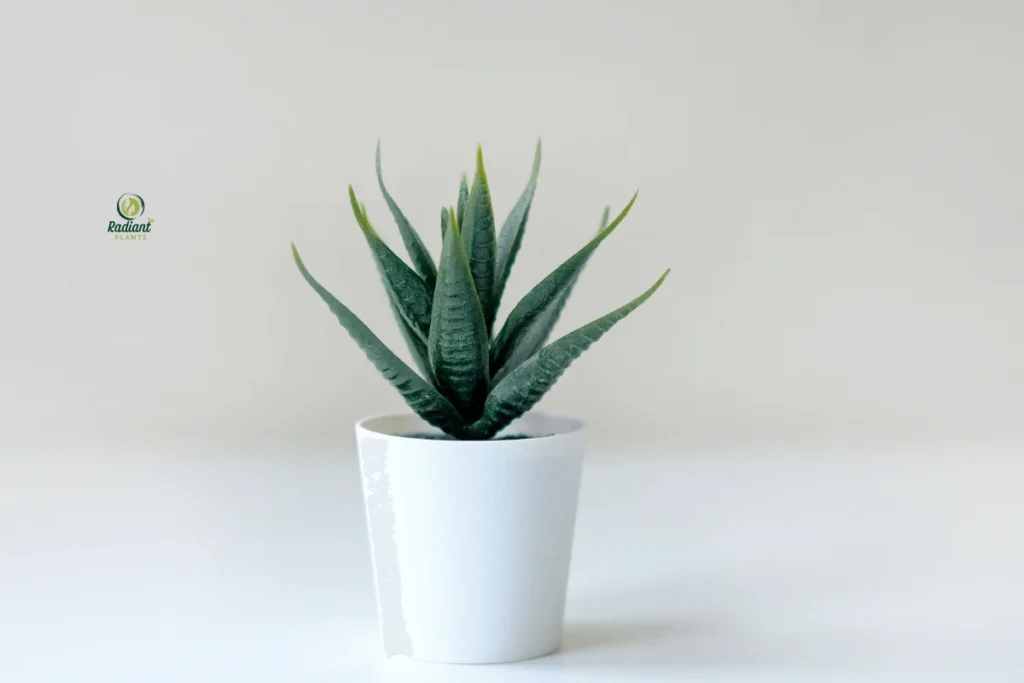
Perhaps the most recognizable desert plant, Aloe vera earns its popularity through both aesthetic appeal and practical applications. This striking succulent doubles as a living first-aid kit.
Aloe enthusiasts appreciate its:
- Medicinal properties and practical uses for minor burns, skin irritations, and more
- Growth pattern and space requirements adapting to various container sizes
- Sunlight needs and seasonal adjustments thrive in bright indirect light
- Harvesting and using aloe gel properly provides tangible benefits beyond visual appeal
While store-bought aloe products abound, nothing compares to snipping a leaf from your plant and applying the cooling gel directly. This connection between ornamental value and practical use makes Aloe vera uniquely rewarding.
4. Jade Plant (Crassula ovata): The Money Tree
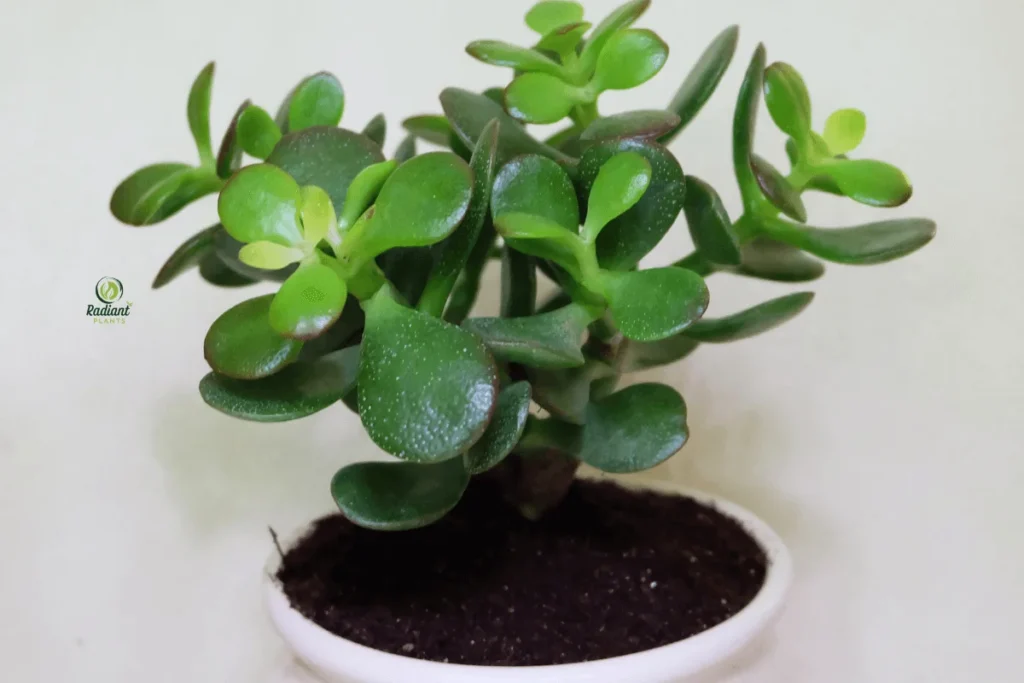
Jade plants bring more than beauty to indoor spaces—they carry symbolic significance in many traditions. With proper care, these miniature tree-like succulents can become heirloom plants passed through generations.
Jade plants feature:
- Symbolic meaning in feng shui is associated with prosperity and good fortune
- Tree-like growth pattern creating a bonsai-like appearance over time
- Long lifespan with proper care, potentially lasting decades or even centuries
- Techniques for encouraging bushiness through strategic pruning and light exposure
The smooth, rounded leaves of jade plants store water efficiently, resulting in their plump, appealing appearance. Their sturdy wooden stems develop with age, eventually resembling miniature tree trunks with substantial character.
5. String of Pearls (Senecio rowleyanus): The Cascading Beauty
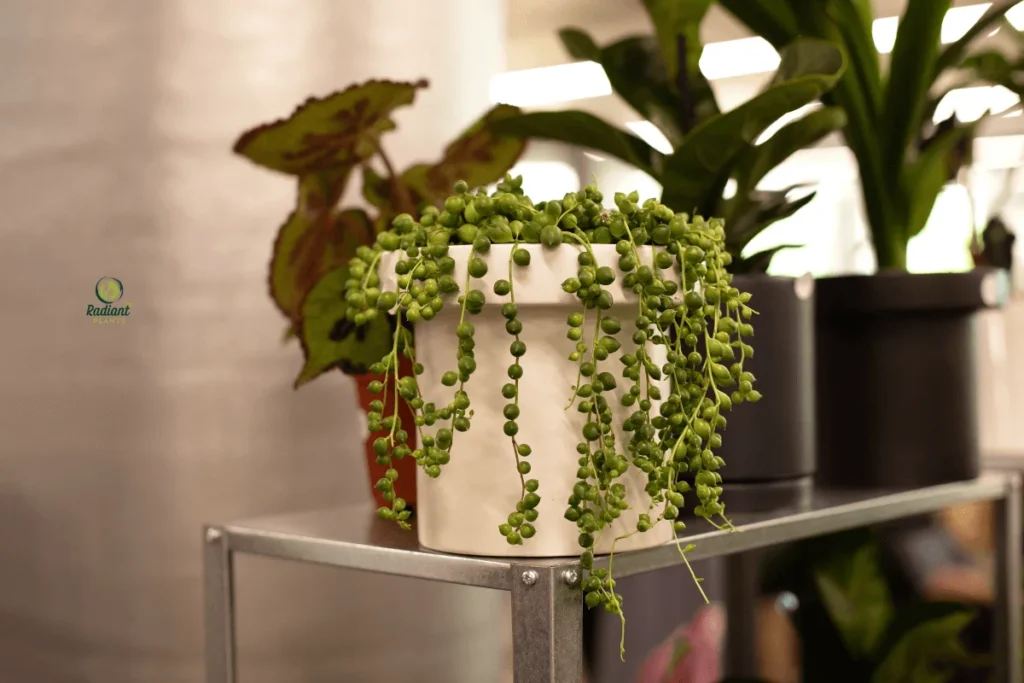
For dramatic visual impact, few desert plants compete with the String of Pearls. This trailing succulent transforms ordinary shelves and hanging planters into cascading green waterfalls.
String of Pearls showcases:
- Dramatic trailing growth habit creates vertical interest in any space
- Display options in hanging planters utilizing vertical space effectively
- Delicate watering balance requires careful attention to thrive
- Protection from direct sunlight prevents damage to the unique spherical leaves
Each “pearl” is a modified leaf that stores water, with a small translucent “window” allowing light to penetrate deeper into the plant. This fascinating adaptation makes them not just beautiful, but botanically intriguing.
6. Zebra Plant (Haworthiopsis attenuata): The Striking Accent
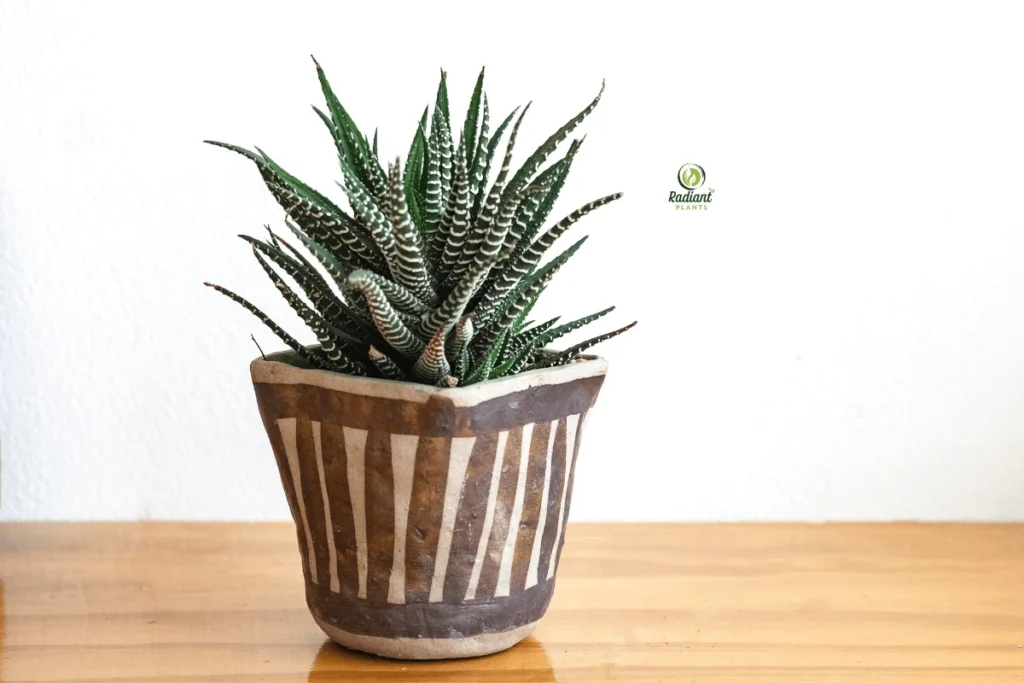
The Zebra Plant makes a statement with its dramatic contrasting patterns. Unlike many succulents that rely on color for visual interest, these desert plants captivate through distinctive textural patterns.
Zebra Plants are characterized by:
- Distinctive white horizontal stripes create a dramatic contrast against deep green
- Slow-growing nature maintains their compact size for years
- Clustering growth habit gradually forming impressive colonies
- Protection from cold drafts, maintaining optimal growing conditions
The striking pattern isn’t merely decorative—the white tubercles (raised portions) help reflect intense sunlight in their native habitat, protecting the plant from sunburn while allowing photosynthesis to continue.
Alocasia Zebrina: The Stunning Tiger-Striped Plant You Need Now
7. Burro’s Tail (Sedum morganianum): The Trailing Stunner
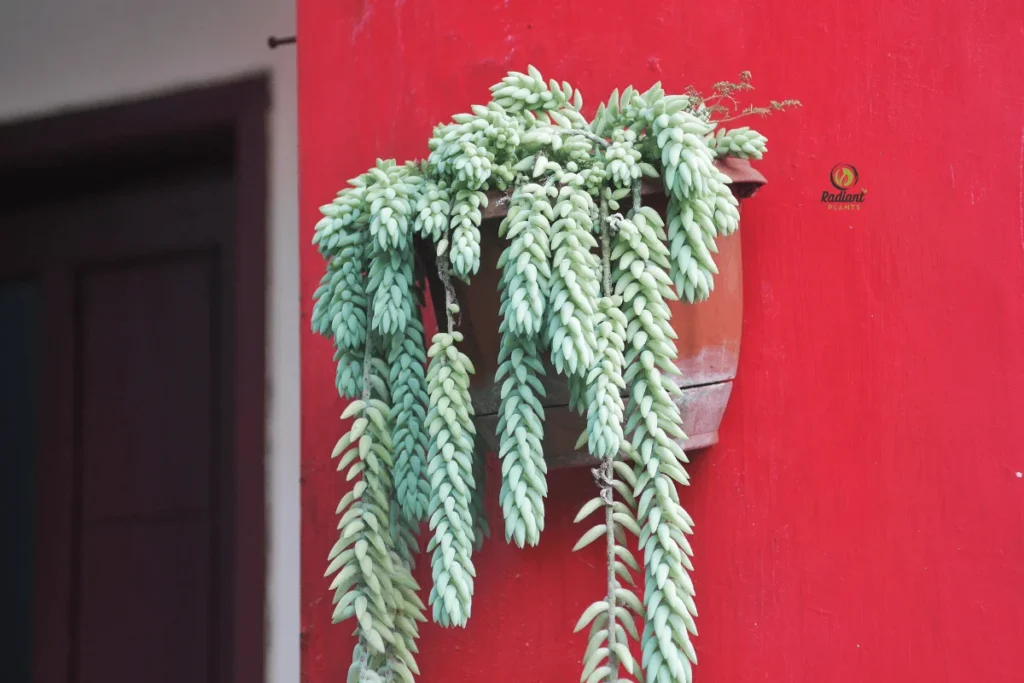
Burro’s Tail creates living curtains of bluish-green foliage that add movement and texture to any space. These remarkable desert plants produce cascades that can grow several feet long when properly maintained.
Their distinguishing features include:
- Unique overlapping leaf structure creating a braided or tail-like appearance
- Fragile nature and handling tips requiring gentle care to prevent leaf loss
- Dramatic length potential offering impressive growth over time
- Patience is required for mature specimens, rewarding dedicated growers
Each plump leaf stores water efficiently, giving this plant exceptional drought tolerance. The leaves attach somewhat loosely to accommodate movement in their natural windy habitats, explaining their tendency to drop leaves when handled.
8. Prickly Pear (Opuntia): The Conversation Starter
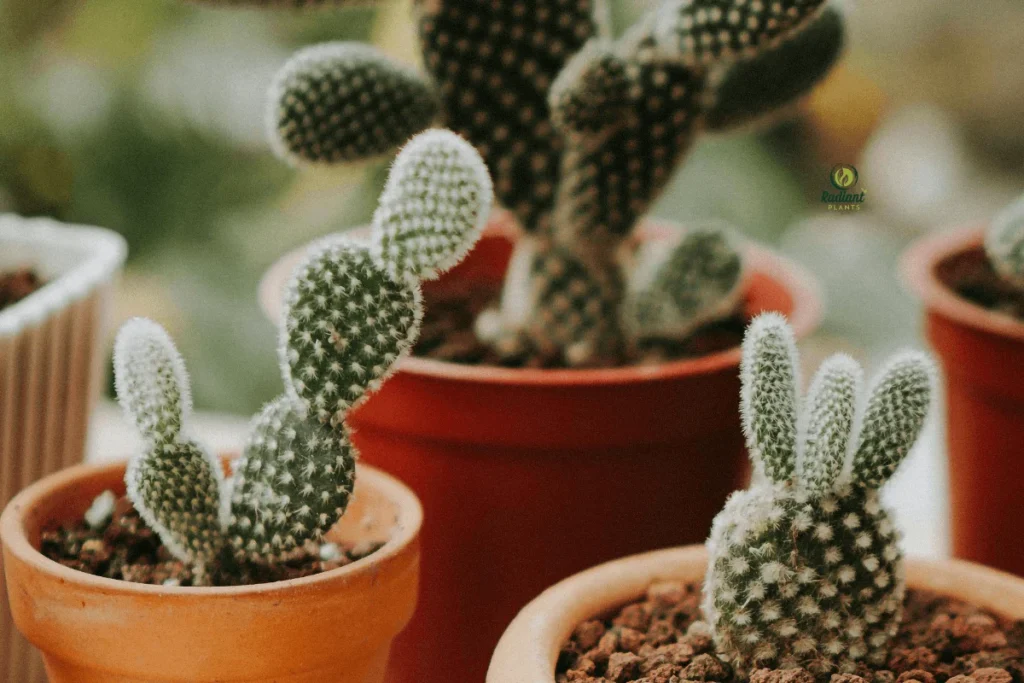
Indoor-friendly varieties of Prickly Pear bring the iconic silhouette of desert landscapes into your home. These distinctive plants immediately evoke the American Southwest with their paddle-shaped pads.
Prickly Pear enthusiasts appreciate:
- Indoor-appropriate varieties sized perfectly for container growing
- Colorful pad development is intensifying with proper light exposure
- Potential for flowering indoors, producing stunning blooms under optimal conditions
- Handling techniques for spiny varieties, ensuring safe maintenance
Select spineless or minimally spined varieties for indoor cultivation. With proper care, indoor Prickly Pears may produce their distinctive fruits—an unexpected bonus from these already remarkable plants.
9. Living Stones (Lithops): The Mimicry Masters
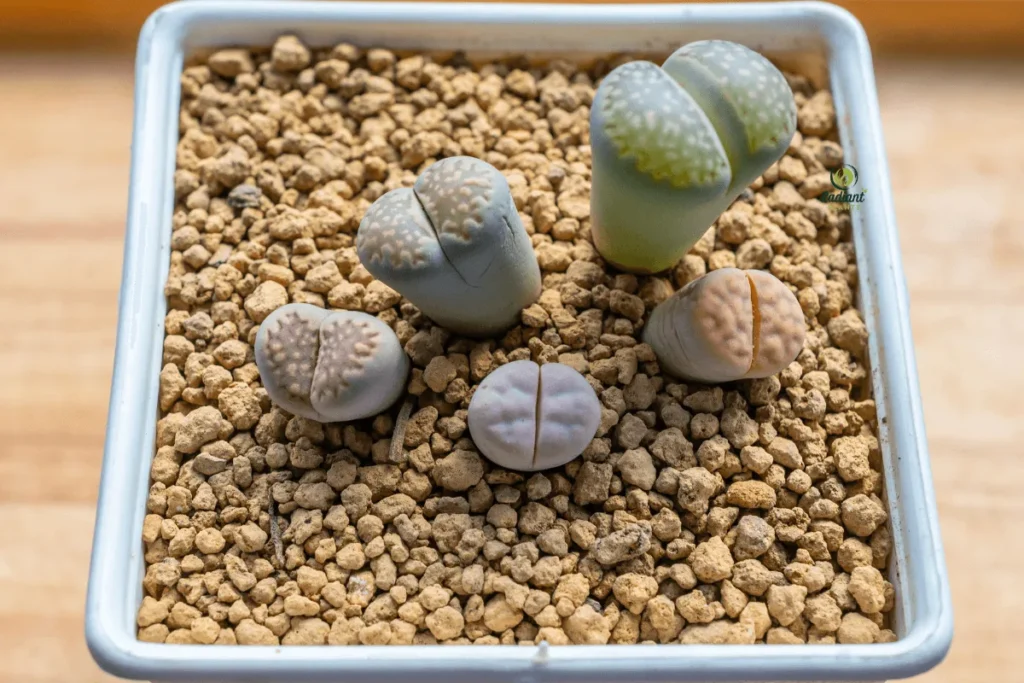
Perhaps the most unusual entry on our list, Living Stones blur the line between plant and mineral. These fascinating desert plants have evolved to resemble the stones among which they grow, creating a botanical optical illusion.
Living Stones fascinate with their:
- Camouflage adaptations create stone-like appearances in various colors and patterns
- Unique watering cycle requiring specific seasonal attention
- Fascinating splitting and renewal process where new growth emerges between existing leaves
- Soil mixture specifics demanding exceptionally fast-draining growing media
Lithops follow an unusual growth cycle—old leaves gradually wither as new ones emerge from the center, with the plant often appearing dormant for extended periods. Their extreme adaptation to desert conditions makes them perfect teaching tools about plant evolution.
10 Stunning Rare Plants You Need to Grow: A Collector’s Guide
10. Snake Plant (Sansevieria): The Indestructible
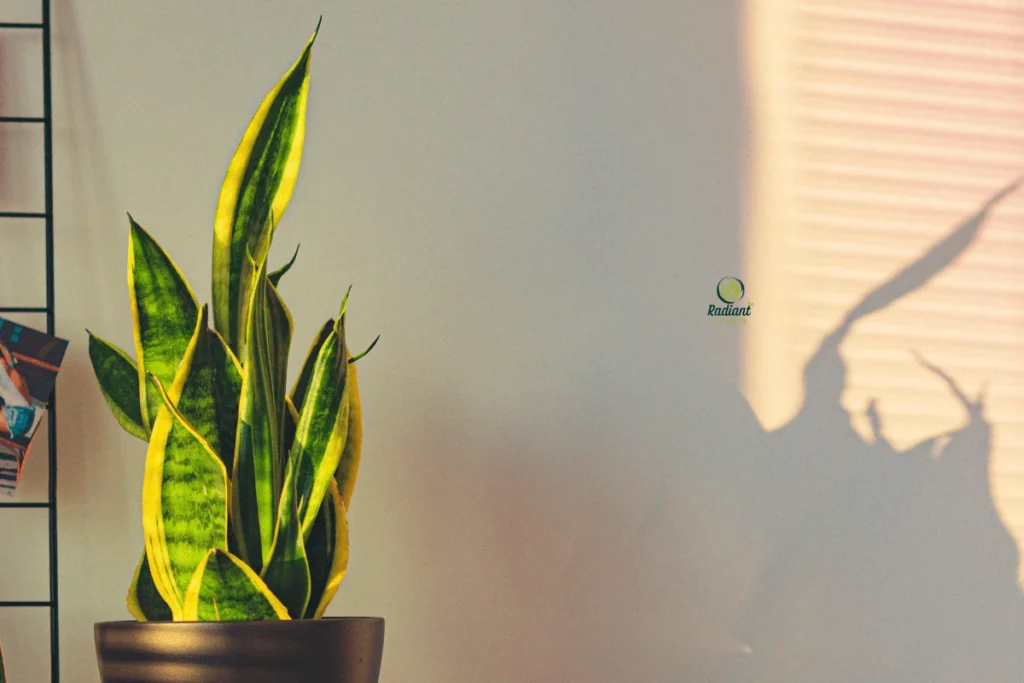
Often recommended as the perfect “starter” houseplant, Snake Plants deserve recognition as striking desert specimens in their own right. Their architectural vertical growth creates bold structural statements in any space.
Snake Plants impress with their:
- Air purification capabilities remove toxins from indoor environments
- Low light tolerance, thriving in challenging locations
- Various sizes and varieties ranging from dwarf cultivars to towering specimens
- Long-term care strategies require minimal intervention
Snake Plants convert carbon dioxide to oxygen at night (unlike most plants), making them particularly beneficial in bedrooms. Their striking variegation patterns and sword-like leaves make them both aesthetically pleasing and practically indestructible.
David Attenborough: The Fascinating Life Cycle of Desert Plants
Essential Care Guide for Indoor Desert Plants
While each desert plant variety has specific needs, certain fundamental care principles apply across most species. Understanding these basics creates the foundation for success.
Watering Wisdom: The Most Critical Factor
Nothing determines succulent success more than proper watering practices. More desert plants perish from overwatering than from any other cause.
Master these essential concepts:
- The “soak and dry” method explained: Water thoroughly until excess drains, then allow soil to dry completely
- Seasonal watering adjustments: Reduce frequency dramatically during winter dormancy
- Signs of overwatering vs. underwatering: Learn to recognize early warning signals
- Water quality considerations: Use room temperature, chemical-free water when possible
This comprehensive watering guide breaks down specific needs by plant type:
Succulent Type | Spring/Summer Watering | Fall/Winter Watering | Special Considerations |
|---|---|---|---|
Rosette Types (Echeveria, Haworthia) | Every 7-10 days | Every 14-21 days | Allow the soil to dry completely between waterings |
Trailing Types (String of Pearls, Burro’s Tail) | Every 10-14 days | Every 21-30 days | Water more when actively growing |
Thick-stemmed Types (Jade, Snake Plant) | Every 14-21 days | Every 30+ days | Rarely during dormancy |
Mimicry Plants (Lithops) | Follow the specific seasonal cycle | Only when actively growing | Follow specific seasonal cycle |
Remember that environmental factors, including temperature, humidity, pot size, and airflow, significantly impact watering frequency. Always check soil moisture before watering, rather than following a rigid schedule.
Light Requirements: Finding the Sweet Spot
Desert plants evolved under intense sunlight, but indoor cultivation requires finding an appropriate light balance. Most succulents need significantly more light than typical houseplants.
Consider these lighting factors:
- Window orientation recommendations: South-facing windows provide ideal light for most varieties
- Seasonal light adjustments: Rotating plants and adjusting placement as sun angles change
- Signs of too much/too little light: Recognizing etiolation, color changes, and sunburn
- Supplemental lighting options: Incorporating grow lights during darker months
Most desert plants perform best with 4-6 hours of bright, indirect sunlight daily. Eastern exposures provide gentle morning light, while western windows offer more intense afternoon rays. Northern exposures typically require supplemental lighting for most varieties.
Soil and Containers: Creating the Perfect Home
Standard potting soil spells disaster for desert plants. Their specialized root systems demand exceptional drainage and appropriate nutrient levels.
Create ideal growing conditions with:
- Specialized succulent soil components: Combining coarse sand, perlite, and minimal organic matter
- Importance of drainage holes: Ensuring excess water escapes easily
- Container material pros and cons: Selecting appropriate materials for your conditions
- Pot sizing considerations: Choosing containers proportional to plant size
This container comparison helps match your plants with appropriate homes:
Container Type | Advantages | Disadvantages | Best For |
|---|---|---|---|
Terracotta | Excellent breathability, moisture control | Heavier, breakable | Most desert plants, especially those sensitive to overwatering |
Ceramic (glazed) | Attractive, stable, water retention | Limited breathability, heavier | Plants that can tolerate slightly more moisture |
Concrete | Modern aesthetic, good insulation | Very heavy, limited drainage | Larger specimens, outdoor-indoor transitions |
Plastic | Lightweight, inexpensive, versatile | Less breathability, can look cheap | Hanging plants, lightweight collections |
Glass | Beautiful for terrarium displays | No drainage, humidity issues | Advanced care only, specific microclimate plants |
Commercial cactus/succulent soil works well for most varieties, though creating custom mixes allows for adjustments tailored to specific plants. Many enthusiasts recommend adding additional perlite or pumice to commercial mixes for improved drainage.
Specialized Tools for Succulent Care
Caring for desert plants becomes easier with the right equipment. These specialized tools make maintenance both simpler and more effective:
- Long-spouted watering cans direct water precisely to the soil without wetting foliage
- Soil moisture meters eliminate guesswork about when to water
- Cactus gloves and tongs protect hands when handling spiny varieties
- Fine brushes for cleaning remove dust and debris from textured surfaces
While not essential, these tools significantly improve the desert plant growing experience, particularly as collections expand beyond a few specimens.
Styling Your Indoor Desert Oasis
Desert plants transcend mere houseplants—they become living design elements that transform spaces. Their sculptural forms and self-contained nature make them ideal for creative display.
Design Principles for Succulent Arrangements
Whether creating single-pot combinations or room-wide displays, these design concepts elevate desert plant presentations:
- Color harmony considerations: Coordinating plant colors with containers and surroundings
- Texture and form contrasts: Pairing spiky, smooth, trailing, and upright varieties
- Height and growth habit combinations: Creating visual movement through varied elevations
- Negative space importance: Allowing breathing room between specimens
The most compelling arrangements balance unity with variety, creating cohesive displays that maintain visual interest through thoughtful contrasts. Consider your desert plants as living sculptures worthy of careful arrangement.
Creative Display Ideas
Move beyond basic pots with these innovative presentation techniques:
- Tiered plant stands showcase collections while maximizing vertical space
- Wall-mounted planters transform ordinary walls into living galleries
- Terrarium landscapes create miniature desert scenes under glass
- Window sill gardens position light-loving varieties optimally
- Desktop micro-gardens bring nature into workspace environments
- Bathroom accents (for humidity-tolerant varieties) soften utilitarian spaces
- Kitchen herb/succulent combinations blend beauty with function
Desert plants particularly shine in unexpected locations—brightening bathroom counters, adorning bedside tables, and transforming home office environments. Their structural forms provide natural focal points in any setting.
Desert-Inspired Interior Design
Extend the desert aesthetic beyond plant selection with complementary design elements:
- Complementary color palettes incorporating terracottas, sands, and sage greens
- Natural material pairings, including untreated woods, stone, and woven textures
- Minimalist styling approaches remove visual clutter to highlight plant forms
- Seasonal display rotations refresh arrangements as plants grow and seasons change
Desert-inspired spaces evoke calm through their uncluttered nature and connection to elemental materials. The restrained palette and emphasis on textural interest create environments that feel simultaneously sophisticated and grounded.
Troubleshooting Common Desert Plant Problems
Even these resilient plants occasionally encounter challenges. Early identification and intervention prevent minor issues from becoming serious problems.
Identifying and Addressing Issues
Watch for these common problems and their solutions:
- Pest identification and organic treatments: Addressing mealybugs, spider mites, and scale
- Disease prevention and management: Controlling fungal and bacterial issues
- Recovery strategies for struggling plants: Rehabilitation techniques for neglected specimens
- When to repot stressed succulents: Recognizing when fresh soil and containers help recovery
This troubleshooting chart helps quickly identify common issues:
Problem | Visual Signs | Likely Cause | Solution |
|---|---|---|---|
Etiolation | Stretched stems, pale growth | Insufficient light | Isolate the plant, treat with isopropyl alcohol on a cotton swab, and monitor |
Root Rot | Blackening base, mushy stem | Overwatering | Remove from soil, cut away damaged parts, allow to callus, replant in dry soil |
Mealybugs | White cottony spots | Pest infestation | Lower leaves are falling off |
Sunburn | Brown/black patches | Sudden exposure to direct sun | Move to filtered light, remove damaged parts |
Leaf Drop | Lower leaves falling off | Natural aging or overwatering | Adjust watering schedule, monitor new growth |
Always quarantine new plants before introducing them to existing collections. This precautionary step prevents potential pest spread and allows observation for any developing problems.
Seasonal Care Adjustments
Desert plants respond to seasonal changes even indoors. Adjust care routines accordingly:
- Summer growth support: Increasing water and occasional dilute fertilizer during active growth
- Winter dormancy management: Reducing water dramatically as growth slows
- Humidity considerations: Monitoring air moisture levels year-round
- Temperature fluctuation protection: Preventing exposure to drafts and extreme temperature changes
Most desert plants enter semi-dormancy during winter months, requiring significantly less water and tolerating lower light conditions. Resume normal care gradually as days lengthen and growth resumes in spring.
Propagation: Growing Your Collection
One of the most rewarding aspects of desert plant cultivation is their remarkable ability to reproduce from minimal material. This trait allows for collection expansion without additional purchases.
Methods for Different Desert Plant Types
Different propagation techniques work best for various desert plants:
- Leaf propagation step-by-step: Perfect for rosette-forming varieties like Echeveria
- Stem cutting techniques: Ideal for branching types, including Jade and Burro’s Tail
- Offset division process: Separating the “pups” that form around parent plants
- Seed starting (for advanced enthusiasts): Growing from seed for genetic diversity
Most propagation methods begin with a clean cut using sterilized tools, followed by a callusing period before planting. This critical drying time allows cut surfaces to heal, preventing rot when exposed to soil moisture.
Creating a Propagation Station
Dedicated propagation areas improve success rates while keeping the growing collection organized:
- Essential tools and supplies: Gathering shallow trays, rooting hormone, and appropriate media
- Ideal conditions for success: Providing bright indirect light and appropriate humidity
- Timeline expectations: Understanding typical rooting and growth timeframes
- Gifting your propagations: Sharing the desert plant joy with friends and family
Most leaf propagations produce visible roots within 2-3 weeks, with small rosettes forming in 1-2 months. Stem cuttings typically root within 3-4 weeks. Patience rewards propagators with dozens of new plants from minimal starting material.
Conclusion: The Endless Desert Journey
Your home deserves the unique beauty and resilience that desert plants bring. These 10 stunning succulents offer not just aesthetic appeal, but a connection to nature that thrives on neglect rather than constant attention. As you embark on your desert plant journey, remember that each spine, leaf, and unusual form tells a story of adaptation and survival—qualities we could all use a little more of in our lives. Start your collection today, and watch as these miniature desert wonders transform your space into a living sanctuary.
Frequently Asked Questions About Desert Plants
How often should I water my indoor desert plants?
Desert plants require much less frequent watering than typical houseplants. For most indoor succulents, waiting until the soil is completely dry before watering again is the safest approach. This typically means watering every 2-3 weeks in summer and once a month or less in winter.
Can desert plants survive in low light conditions?
While most desert plants prefer bright light, some varieties like Snake Plants, Haworthia, and certain Aloe species can tolerate lower light conditions. However, even these plants will eventually stretch and lose their compact form without adequate light.
Why are the leaves falling off my desert plants?
Leaf drop in desert plants is often a sign of overwatering. When succulents receive too much water, their leaves become swollen and may eventually fall off as the plant attempts to prevent rot. Check your watering schedule and ensure your pot has adequate drainage.
Do indoor desert plants need fertilizer?
Desert plants have evolved to thrive in nutrient-poor environments, so they require minimal fertilizing. A diluted succulent fertilizer applied once during the spring growing season is usually sufficient for indoor desert plants.
How do I know when to repot my desert plants?
Most desert plants grow slowly and prefer to be somewhat root-bound. Signs that repotting is needed include: roots growing through drainage holes, water running straight through without being absorbed, top-heavy plants falling over, or no growth for extended periods despite ideal conditions.
Can different types of desert plants be planted together?
While many desert plants can coexist beautifully, it’s best to group plants with similar care requirements. Consider factors like growth rate, watering needs, and mature size when creating mixed arrangements of desert plants.
Ready to transform your space with these resilient beauties? Start your desert plant collection today with just one or two of these spectacular succulents. Share your indoor desert garden photos with us using #IndoorDesertOasis and join our community of succulent enthusiasts. For personalized advice on your specific growing conditions, sign up for our monthly desert plant care newsletter. Your journey into the fascinating world of desert plants begins now!

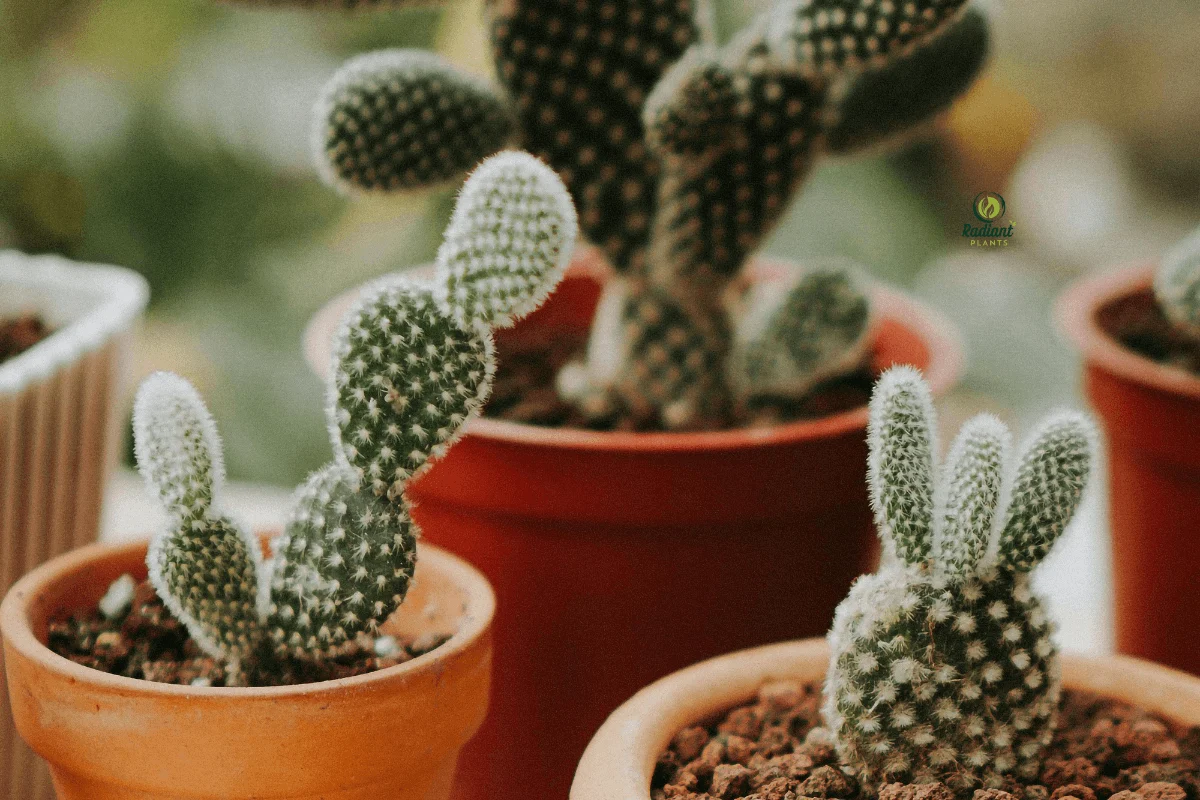
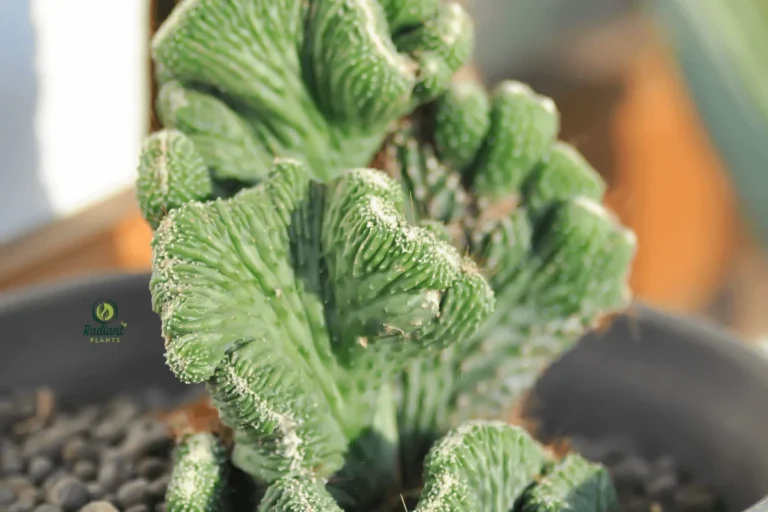
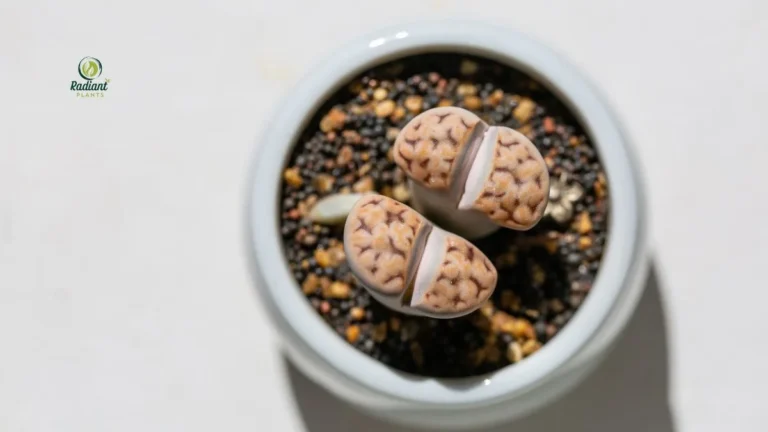
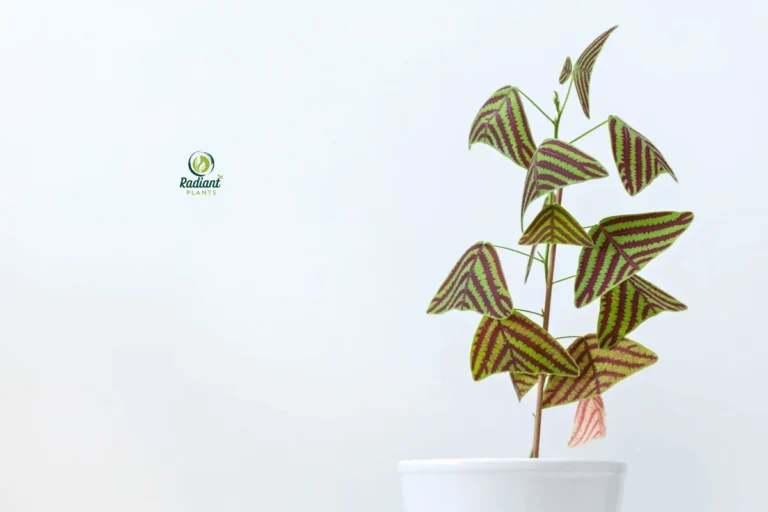
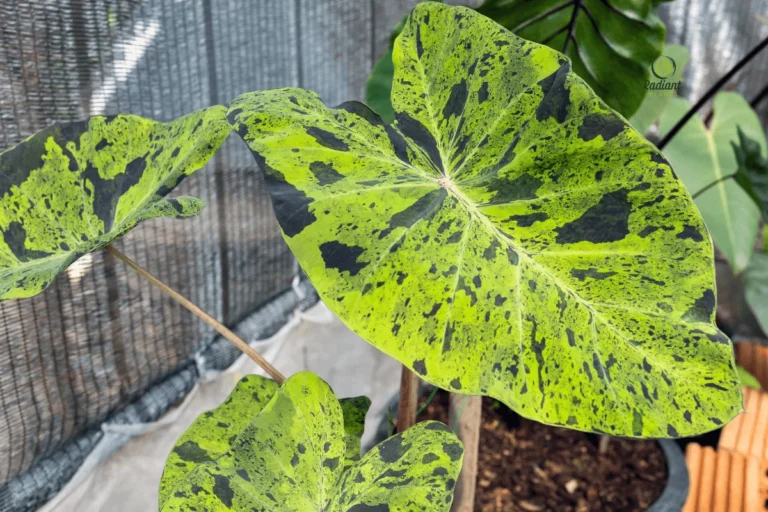
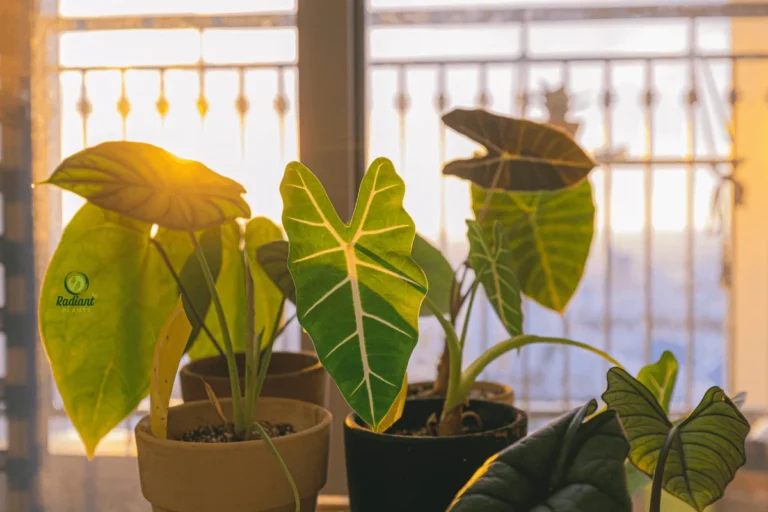
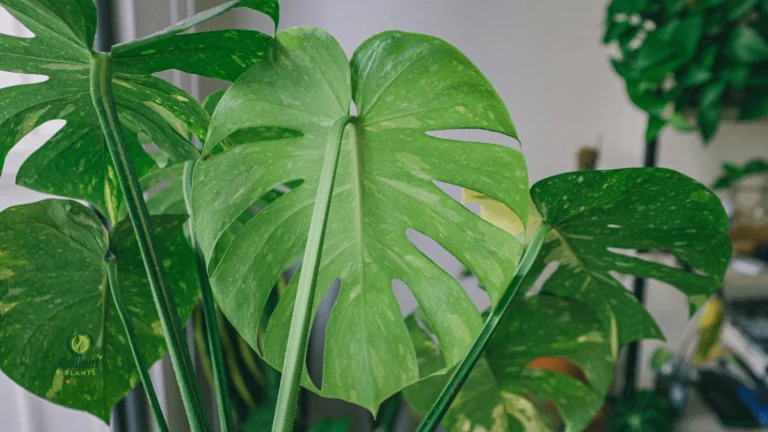
One Comment